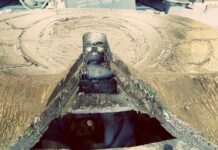
The best air hammer, also called an air chisel, is a hand operated pneumatic tool meant for cutting different metals and stones.
They work well for removing control arm bushings, popping out CV joints, or peening/bucking solid rivets. A good chisel will make life in the automotive garage so much easier.
These tools comes in different designs to hold different tips as demanded by the operation it needs to carry.
Find heavy duty air hammers under $200 on Amazon.
Selecting pneumatic hammers
- Look for a good selection of hammer tips with the hammer.
- Find out the maximum workload pressure, and see that the maximum pressure suits the tasks.
- Pneumatic hammers depend on air inlet sizes for working efficiency, so pay attention to this variable.
Pneumatic hammers are undoubtedly among the most useful of power tools. Unlike tools for specific purposes, pneumatic hammers have hundreds of uses. Automotive uses include tie rod end removal, metal blandishment, and muffler cutting. It’s important, however, to use the right pneumatic hammers, bits, and accessories.
What to consider when purchasing a good air chisel
Pneumatic hammers for the auto industry display the following characteristics: power per square inch, barrel length, piston weight, blows per minute, and the amount of air necessary for operation at a rated number of blows.
Warranty: The first consideration is one of warranty. The hammer should be warranted by an established, reputable manufacturer with service facilities.
Power: Power is another main consideration. Most auto technicians need medium- to heavy-duty pneumatic hammers for their tasks. An example would be an air-impact hammer producing up to 3,000 blows per minute.
Short barrel vs long barrel: Light-duty pneumatic hammers with short barrels are sufficient for cutting through body panels and can be a bit difficult to manage while working in awkward areas.
Short-barrel medium-duty pneumatic hammers are useful for cutting thin sheet metal and removing wheel studs and are more suited for jobs needing slightly more control.
Long-barrel, heavy-duty pneumatic hammers tend to be the most useful; sometimes their only limitation is the supply of available bits.
Trigger: Gradually progressive triggers are nice, and not all pneumatic hammers have them. As pneumatic hammers can cause serious bodily harm, gradually progressive triggers are relatively safer because they give technicians the most control over hammer operation.
Starting capabilities and specifications for a good pneumatic hammer:
- Power enough for 2,100 to 3,500 blows per minute
- Stroke length between 2-5/8 and 3.0 inches
- Compressor CFM average output from 3.2 for low to 13 for high impact
- Continuous pressure of 90 PSI
- Minimum hose diameter of 3/8-inch
A heavy-duty pneumatic hammer with a good warranty along with high-quality carbon steel bits for versatility and longevity would be the best buy.
Compressors have four specifications: Tank size, motor horsepower, air volume output in cubic feet per minute (CFM), and air pressure in pounds per square inch (PSI). CFM and PSI are the significant numbers to consider for compressors, the volume of air the compressor can create per minute and the air pressure in the tank.
Each pneumatic hammer requires a minimal CFM at a prescribed PSI to operate properly and at full efficiency. The larger the pneumatic hammer the more powerful the compressor needed to run it. As an example, if a pneumatic hammer needs at least 4 CFM at 90 PSI, any compressor with a >4 CFM rating will do.
Tank Size: Tank size is important only where space is limited. The compressor must be compatible with the pneumatic hammer airflow PSI for best performance. Pneumatic hammers for home use should indicate these specifications. Rotary-vane, fast-recovery compressors for commercial shop use are compatible with air tools generally and a variety of pneumatic hammers.
No swinging required
Pneumatic hammers require no swinging so they do not tire users as quickly as do manual hammers. This feature is especially welcome on large projects with lots of nailing, drywall installation, for example. Use of pneumatic hammers helps to avoid cramping and fatigue, allows work to continue longer, and finishes it faster and more efficiently than possible with manual hammers.
Pneumatic hammers are also safer than are traditional hammers. As there is no need to hold the nail in place, there is no risk of striking a hand or finger.
Manually hammering nails is tiring and takes lots of time. A pneumatic hammer speeds the job up considerably. The number of nails hammered increases while the time needed to hammer them decreases.
Pneumatic hammers are for sale in home improvement or hardware stores and readily available online for shopping most conveniently, from home. Many different brands are available with various features. Consider the types of uses and the frequency of use to determine the brand and features needed. Comparison shopping helps to find the best bargain.
Find the best air hammer for front end work on the market in 2023 on Amazon.
Originally posted 2023-01-06 01:05:31.


